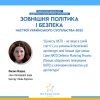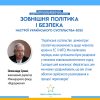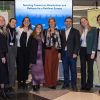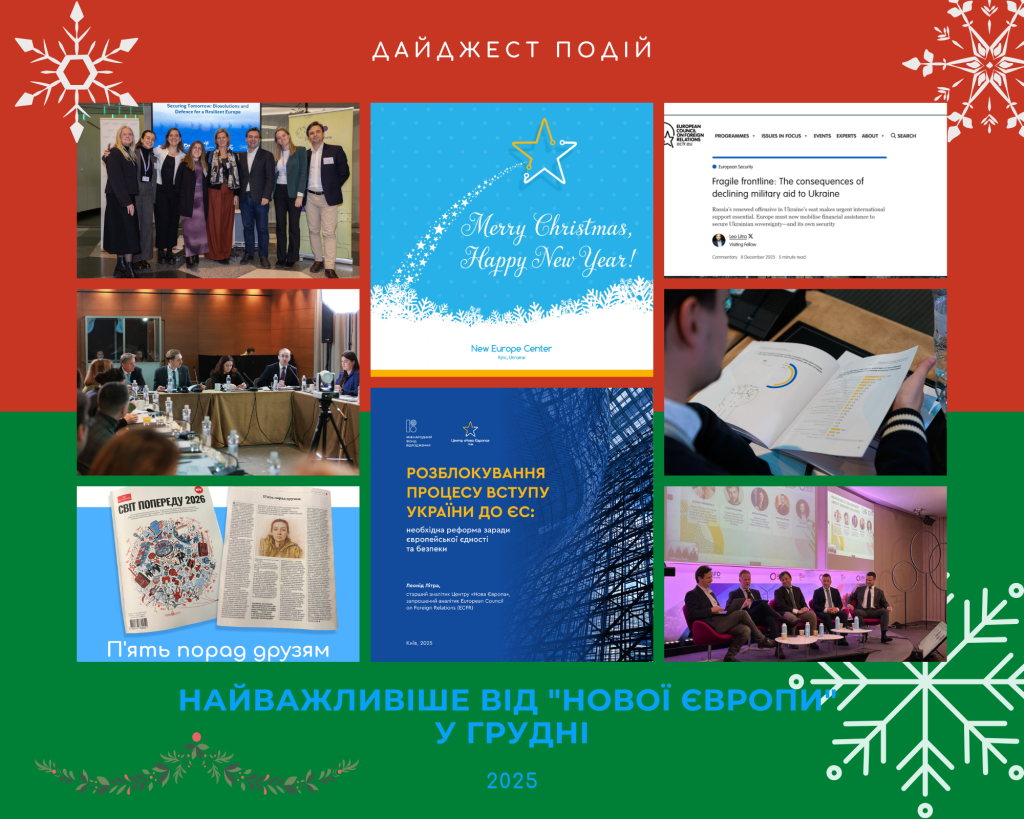This discussion paper was conducted by the New Europe Center as part of its project implemented under the USAID/ ENGAGE activity, which is funded by the United States Agency for International Development (USAID) and implemented by Pact. The contents of this discussion paper are the sole responsibility of Pact and its implementing partners and do not necessary reflect the views of USAID or the United States Government.
This paper was prepared on the basis of a public discussion held in Mariupol (April 9, 2019), as well as a series of interviews with representatives of the local community. The author analyzes political, security,
and economic aspects of the development of Donetsk region in the context of the European integration
Find the PDF version of the document here.
THE LAST OUTPOST OF DONBAS: WHAT DO RESIDENTS OF MARIUPOL THINK ABOUT EUROPEAN INTEGRATION?[1]
Tetiana Levoniuk[2]
The author expresses her gratitude to Sergiy Solodkyy and Kateryna Zarembo for their contributions to the research
The East of Ukraine has traditionally been one of the most euroskeptic regions of the country. Five years after Euromaidan and the beginning of Russian aggression, the number of supporters of the pro-European agenda has not changed significantly. For instance, in 2013, 18.4% of the respondents in the East supported the accession to the EU, while by 2019, the level of support for the accession to the EU amounted to 25%.[3] [4] [5] Moreover, while the capital is focused on its own agenda, the views of the residents of the regions still remain far from Kyiv’s attention.
According to a poll conducted by GfK Ukraine at the request of the New Europe Center, 54% of Ukrainians agreed on the need to continue the European integration processes in Ukraine. Ukrainians are aware of the expediency of reforms in the country, even without the prospect of membership in the European Union. However, in the East of Ukraine, less residents agree with this statement (slightly over 30%). By the way, in the East, only 9% of the respondents feel a positive effect of Ukraine’s rapprochement with the EU, and this figure is twice as low as the nationwide one[6].
This paper, prepared on the basis of a public discussion held in Mariupol[7], as well as a series of interviews with representatives of the local community, analyzes the political, security, and economic aspects of the development of Donetsk region in the context of the European integration. However, it should be noted that the residents of Mariupol have their own peculiarities in terms of the attitude toward political and economic processes in Ukraine and also perceive themselves as part of the Azov, not the Donetsk region.
This perception exists partly due to the fact that there was competition for leadership between Mariupol and Donetsk historically. Local residents can complain that Mariupol has been financially deprived for a long time since the funds have been directed to the regional center. As the residents of Mariupol believe, while Donetsk was being built, their city has been degrading.
ATTITUDES TOWARDS THE EU
The East and South of Ukraine are the most skeptical about the reforms and the European integration, even after Ukraine managed to contain Russia’s offensive and start a series of reforms. Half of the residents of Donetsk region do not consider Russia as an aggressor (according to a research conducted by the sociological group Rating, the actions of Moscow are considered as aggression by 32% of respondents[8]).
According to the same research, 48% of Donetsk region’s residents would vote against Ukraine’s accession to the EU at a possible referendum. These figures, as we see, actually coincide with the level of assessment of the aggressive actions of Russia. At the same time, there is a fairly high number of those who share a neutral position. When choosing among the three foreign-policy options/directions, only 22% of the residents of the region prefer the European Union, 21% support the Customs Union, and the largest group (42%) consists of those who stand for the equidistance from both the EU and Russia[9]. Our previous researches conducted in Kharkiv, Odesa, and Kherson have already drawn attention to the numerous “neutralists” that either actually remain within an atmosphere of fear and uncertainty or represent latent pro-Russian attitudes.
The East and South of Ukraine are the most skeptical about the reforms and the position of European integration, even after Ukraine managed to contain Russia’s offensive and start a series of reforms. Half of the inhabitants of Donetsk region do not consider Russia as an aggressor (according to a study by the sociological group “Rating”, the actions of Moscow are considered as aggression by 32% of respondents).
It is possible that the poll did not take into account all the nuances at the local level; perhaps, a sociological research in Mariupol itself would be somewhat different from the regionwide figures. Although the observations of leaders of public opinion in Mariupol are based on the conclusion that in the last five years, the number of supporters of the pro-Russian vector has not changed significantly, as well as the number of those who support the European integration.
In Mariupol, a single political force is dominating, and the city administration consists of former employees of Metinvest, an international mining and metal production group. The structure of the group includes mining and metallurgical enterprises in Ukraine, Europe, and the USA. Six of the eight Deputies of the Mayor of Mariupol, including the Mayor himself, had previously collaborated with Metinvest. In general, Mariupol is currently called Rinat Akhmetov’s political and economic turf. There is also an impact on the media space of the city: most of the local media outlets are owned by Metinvest.
In the Transparency International’s Transparent Cities Rating of November 11, 2018, Mariupol took 2nd place among the 100 largest cities of Ukraine[10]. The report notes that reporting at the local level has become transparent, and the level of trust of foreign donors to local administrations is increasing.
In Mariupol, as well as in Kharkiv or Odesa, there is a lack of visual marking of projects and accomplishments achieved through EU funding; thus, the improvements are often perceived as deeds of local administrations and individuals. A successful example of effective communication is three trolleybuses donated to Mariupol marked with the symbols of the European Union.
After the beginning of Russian aggression, Mariupol, like Kramatorsk, turned into one of the “political tourism” destinations often visited by foreign delegations (foreign diplomats sadly dub this phenomenon as “a kind of safari”). In this sense, another city of the Azov region, Berdyansk, can be considered a forgotten one.
THE ROLE OF THE COMMUNITY
After 2014, a relatively influential core of public activists has been formed. At the same time, local civil society is generally disparate.
According to the results of the European Union Anti-corruption Initiative in Ukraine (EUACI)[11], in 2019, the actual number of active operational civil society organizations (CSOs) in 5 cities of Ukraine, including Mariupol, differs significantly from the total number of registered ones. For example, 650 CSOs have been registered in Mariupol but only several dozen can be considered active at the best[12].
For instance, the Skhidna Brama (Eastern Gate) NGO has been a volunteer center that helped military personnel with supplies since 2014. In addition, it had conducted a series of mediation and negotiation master classes, has been a partner of the Kyiv Dialogue project, etc.
The Mariupol Development Fund, in its turn, is the only organization that cooperates with donors and the city administration to implement infrastructure projects. Certain public activists criticize this organization for excessive dependence on local authorities, but the Fund itself considers such criticism unsubstantiated.
Our interlocutors in Mariupol cited a case of March this year as an example of an effective community engagement. Mariupol authorities decided to disassemble a kiosk-cafe owned by an ATO veteran. After a sharp community reaction, the authorities quickly solved the problem by finding an alternative location for the kiosk[13]. It should be noted that the majority of such cases are being put to the discussion on Facebook, which allows the activists communicate local problems outside of Mariupol and attract attention.
Representatives of civil organizations emphasize a number of challenges for the development of the city: in particular, they favor discussing reconstruction projects and creating venues for the CSOs to communicate with each other and with other organizations and city authorities[14].
Representatives of local authorities emphasize in their public speeches the importance of adherence to the standards of accountability and transparency in the context of the European integration. There is an understanding that openness is a guarantee of trust both from the city’s residents and investors who could invest in the region. Local opinion leaders consider decentralization a positive phenomenon: as a result of it, the local budget has increased (UAH 5.04 billion as of 2018[15]). Representatives of the public also consider the possibility of influencing individual lines of the budget (“participation budget”) a positive sign. However, the opponents of the authorities also criticize them: they claim that an increase in the budget is a real chance for the city to develop, but also a chance for the rise of corruption according to one of the residents, “now the money will settle in the pockets of local authorities, not in Kyiv”) The active part of the city residents shows a considerable level of distrust toward the actions of the city leadership.
The environmental situation in Mariupol is another problem that causes waves of protests (in 2012, one of the demonstrations has been attended by more than 10 thousand people). According to the Ministry of Ecology and Natural Resources, in 2017, two Mariupol-based companies have been included into the list of top 10 air pollutants: Ilyich Iron and Steel Works and Azovstal[16]. By the way, the local community already has a solid experience of “environmental friendliness enforcement” imposed on industrial giants. For example, environmental activist and city council deputy Maksym Borodin had purchased equipment to measure air pollution not only for Mariupol, but also for a number of other cities[17]. The protection of the environment could become one of the key components of the European integration process in Mariupol.
ELECTIONS AND THE EU
The European integration has not become a part of the agenda of the presidential campaign in the region (the Opposition Bloc, with its critical attitude toward the EU, enjoys the highest level of support here). Among the local deputies, the Opposition Bloc dominates (45 mandates), while the rest of the seats is occupied by the representatives of Nash Krai (Our Land) (4) and Syla Liudei (People’s Power) (5)[18].
For the local residents, the problem of resolving the conflict in the East is more urgent than the European integration. Thus, political forces that promote the idea of “compromise” can gain more electoral points.
It is interesting to compare the electoral situation in Mariupol. For example, in 2014, the voting turnout in the presidential election was as low as 15% (at that time there were significant problems with the organization of elections in Donbas caused by the aggression of Russia), while this year the respective figure was almost 60%. Five years ago, Petro Poroshenko had won in Mariupol (with 38% support). This year, the first round has been won by Yuriy Boyko with a slight advantage (30%). Volodymyr Zelensky has taken the second position, having received two percent less. It should be also noted that Oleksandr Vilkul received 20% support[19]. It is obvious that the electorate of Boyko and Vilkul (in general, 50%) is unlikely to be attracted to the intensive advancement of the pro-European course. Petro Poroshenko received only 6% of the votes of Mariupol residents this time.
In the second round, 90% of the residents of Mariupol supported Volodymyr Zelensky[20]. These results allow us to predict the outcome of the parliamentary elections: the majority of the residents of Mariupol will vote for the parties that do not prioritize the European integration.
SECURITY AND SUPPORT OF THE EU
Mariupol is often called the last outpost of Donbas. This city has a strategic value and is a potential showcase, which in the long run may be attractive to the residents of the occupied territories if they see positive changes in the neighboring region.
A certain part of local population still lives in the Russian information field: Russian TV channels are still broadcast in half of the territory of the Donetsk region, and Ukrainian television is not available in many areas. Moreover, sometimes even Ukrainian mass media resort to manipulations, accusing the activists of attracting attention to issues beneficial to Russia (such as increase of public transport fares).
After Russia’s aggression against Ukrainian ships, Mariupol found itself at the center of global attention. The European Union Mission, led by Thomas Mayr-Harting, Managing Director for Europe and Central Asia in the European External Action Service, and Peter Wagner, Director of the European Commission`s Support Group for Ukraine, arrived in Mariupol to study the situation in the region this winter. Subsequently, EU Foreign Ministers approved a package of assistance for the region, including 10 strategic projects (effectively, it combined the already existing EU initiatives). The city itself knew little about the approved package, which underlines the importance of an appropriate communication. It should be emphasized that the EU will probably be practicing a kind of more decentralized approach to cooperation with Ukraine in the future, as it is expected that the implementation of projects at the regional level will be more visible and perceptible to the ordinary Ukrainians.
The demonstration of political solidarity with Ukraine in general and the Azov region in particular against the backdrop of Russia’s aggressive policy in the region is an important security factor. Western diplomats note that Russian diplomacy is showing increasing interest in any visit of a Western politician to the region. Such visits or the activities of long-term diplomatic missions involving representatives of the West is one of the possible safeguards against the aggressive actions of Russia. However, it should be taken into account that the EU avoids supporting any projects related to security or law enforcement. Instead, the EU countries predominantly prefer implementing infrastructure projects. A vivid example is a French loan of EUR 64 million to build a modern water purification and decontamination complex in Mariupol[21].
The representatives of the previous government expressed the hope that Western countries (referring to the NATO) would provide their observers to be on board of Ukrainian military vessels passing through the Kerch Strait to the Azov ports. Such an idea needs further development under the new President.
ECONOMY AND INFRASTRUCTURE
Despite security, humanitarian, and environmental challenges facing the Donetsk region, it still manages to keep pace with others in terms of exports to the EU. During 2018, the subjects of the economic activity in the region had carried out international economic operations with partners from 125 countries. The main markets for the goods of the region’s businesses were the EU states (50.4% of total exports), the CIS (16.6%), Asia (15.9%), America (11.1%), and Africa (5.4% ) Among the most significant trade partners for the export of goods in 2018, were the following countries: Italy (25.6% of total exports), the Russian Federation (12.5%), the USA (9.4%), Poland (6.7%), and Turkey (6.6%). The largest imports of goods came from the Russian Federation (31.4% of the total imports of the region), the USA (32.9%), Canada (6.2%), China (5.2%), Germany (3.8%), the Czech Republic (2.9%), and Kazakhstan (1.8%)[22].
First and foremost, Mariupol is associated with the metallurgical industry. The share of metallurgy export products in the international trade turnover is about 70%. Over 50 countries purchase products of Mariupol-based metal and iron works[23].
According to official data, the level of registered unemployment in Mariupol is low (4.5 thousand persons last year)[24]. However, there is a considerable number of those who do not register at the Employment Center: according to local respondents, low wages force the most active citizens leave the city and to move to either larger Ukrainian cities or abroad. The EU-funded investments in new production pipelines and business conditions, for instance, through the EU-funded business incubators, and project banks for investors are among the scenarios anticipated by a part of the residents of Mariupol.
Within the framework of the EU EU4Business program, an agreement has been signed between the EU and the European Bank for Reconstruction and Development (EBRD) to establish 15 support centers for small and medium business in the regions of Ukraine[25]. The first of such centers have been opened in Lviv, Kyiv, Odesa, etc. to a larger extent through local chambers of commerce. Such a center exists in Kramatorsk; therefore, it is possible to open a virtual office in Mariupol through Kramatorsk (given that the EBRD does not fund projects within 30 km in the military zone, which includes Mariupol). On the other hand, this example also illustrates the problem of shifting responsibility. Both local business and the state authorities are hoping for donors and sometimes lack their own lead.
In 2018, the share of small and medium businesses (SMEs) in the total tax revenues to the city budget amounted to 598 million. The number of SMEs in Mariupol is gradually increasing (in the 4th quarter of 2018, the number of SMEs exceeded the respective figure of the 1st quarter of 2017 by 12%); however, Mariupol still lags behind the nationwide average number of SMEs per 100,000 population (as of 2017[26]).
The development of better transport links with the EU could also affect the perception of the European integration. However, it should be noted that 80% of the population of the Donetsk region had never left the region, while some had never even left their home city. The development of infrastructure, particularly railways, autoroutes, and, possibly, air links between Mariupol and the rest of Ukraine should be one of the important objectives. The residents of Mariupol see their city as an island cut off from the rest of the country. Before the war, they could get to Kyiv in 6 hours, while today, it takes 10-12 hours at best. The duration of a trip between Kyiv and Mariupol by train is 18 (!) hours. A new night express has been launched recently; however, a reduction of travel time to 15 hours is not a significant change. The residents of Mariupol are counting on reconstruction of the autoroute to Zaporizhzhia, and ideally, on improvements in communication with Kyiv and Odesa.
It should be noted that during the last year’s visit of Chancellor Angela Merkel to Ukraine it was declared that the funds for the reconstruction of the autoroute Zaporizhzhia-Mariupol will be taken from EUR 500 million loan granted by Germany to Ukraine in 2015, namely, for the reconstruction of Donbas[27].
This year the Government has announced the allocation of UAH 1 billion for the reconstruction of the autoroute between Zaporizhzhia and Mariupol. The plans also include a complete modernization of a part of the railway in the same direction[28].
Since 2016, Mariupol has received 113 new public transport units: trams, trolleybuses, and buses. This funding includes not only the budget funds of the city and the region, but also financial assistance from the European Union within the framework of technical assistance. On February 5, an agreement has been signed with the International Finance Corporation (IFC), which provides for a targeted loan of EUR 12.5 million. In addition, with the support of the European Bank for Reconstruction and Development (EBRD), the city will procure another 72 trolleybuses[29].
During the discussion, it has been noted that today, the European Investment Bank’s credit program to restore Ukraine, aimed at overcoming the consequences of Russian aggression in Eastern Ukraine, is being implemented in the Donetsk region. By that time, 146 projects with total value of over 2 billion UAH have been approved. These projects mostly focus on addressing the needs of internally displaced persons (IDPs) and reconstruction of houses, healthcare facilities, and other social infrastructure. This was critically important for the city, as only in 2014, Mariupol with population of 480 thousand residents took in 17.5 thousand IDPs[30].
COMMUNICATION OF THE EUROPEAN INTEGRATION
The multidimensional nature of the information about processes related to the EU makes communication about the European integration in Ukraine a rather difficult and long-term task. In the East and South of Ukraine, where a narrative of the “negative consequences of the European integration” remains strong, explaining the advantages of the European integration and convey the essence of reforms is more difficult than in other regions of the country.
In general, Ukrainians often ask about personal benefits when it comes to the European integration. In the East, in particular, people are interested in concrete economic prospects of the membership in the EU and requirements that Ukraine should meet. This means that the majority of people do not understand what the accession to the EU means and what the program of European integration reforms should be, and this is a misstep of the executive power, including its local branches.
The European integration is not only about business but also a wide range of opportunities for the development of science and education, in particular through the Erasmus+ and Horizon 2020 projects, which also engage the universities of Mariupol. The Mariupol State University, for example, has signed about 30 agreements with European higher education institutions, under which its professors and students have the opportunity to exchange experience abroad through the EU budget[31].
In addition, Europe Days are held in Mariupol. The information center of the European Union operates on the basis of the Mariupol State University. It is vital that a relatively small camp of supporters of the European integration does not feel abandoned by Kyiv and the EU representatives. There should be more public events devoted to the EU and the European integration. And there should be even more real evidence of concrete success.
RECOMMENDATIONS:
- For the residents of Mariupol, small but vivid changes made with the assistance of the EU are a positive sign of European integration. It is important that the EU assistance is not only available, but also visible through the appropriate marking, and the adoption of large projects is actively communicated among the population by the EU and local authorities.
- The establishment of diplomatic missions in Mariupol with the participation of representatives of the Western states is one of the possible safeguards against the further aggression of Russia. Ukraine should also continue promoting the idea of deploying observers from Western countries on board of Ukrainian military ships passing through the Kerch Strait to Azov ports.
- Compared to Berdyansk, Mariupol is not a forgotten city, but aside from high-level visits and significant number of trainings and expert discussions, there is a need for specialists in various sectors from the EU countries who could train their colleagues to use resources efficiently and organize city processes properly.
- Local residents are hoping to create new production pipelines and business opportunities. Business incubators, project offices, and the establishment of a virtual center for small and medium-sized businesses through Kramatorsk will contribute to the development of Mariupol and reduce the outflow of population, in particular young people leaving the city in search of employment.
- The development of infrastructure, namely railways, autoroutes and, possibly, air links between Mariupol and the rest of Ukraine, is critical not only for the European but also for the social integration of Mariupol with the rest of the country.
- Environmental protection could become one of the key elements of the European integration of Mariupol, as the problem of air pollution is extremely urgent for the city. Therefore, environmental projects could become the most visible examples of EU assistance.
[1] This discussion paper has been prepared within the framework of the New Europe Center initiative aimed at researching the attitudes toward the European integration in the regions of Ukraine. The analytical paper on Kharkiv has been published in June 2018 and is available at the following link: http://neweurope.org.ua/analytics/pro-shho-movchyt-harkiv/. An analytical paper on Odesa and Kherson has been published in November 2018 and is available at the following link: http://neweurope.org.ua/wp-content/uploads/2018/11/Brief-Odesa-and-Kherson_hilight_ukr.pdf
[2] The author expresses her gratitude to Sergiy Solodkyy and Kateryna Zarembo for their contributions to the research.
[3] Which way Ukraine should go, which union should join? (population preferences for two weeks before the Vilnius Summit). 26.11.2013.
[4] Social and political sentiments of the population of Ukraine on the eve of the first round of the presidential elections: March 2019.25.03.2019.
[5] In the 2013 poll, the Eastern macroregion included controlled areas of Luhansk and Donetsk regions, while in the 2019 poll, Donbas was placed in a separate group. However, the percentage difference in support for the accession to the EU in 2019 was insignificant: -23.3% of respondents in the East and -25% in Donbas.
[6] What kind of foreign policy are Ukrainians expecting from the next President?
[7] The public discussion has been held in Mariupol on April 9, 2019.
[8] The special project by the Rating group: The portraits of the regions: Ukraine, December 2018. http://ratinggroup.ua/files/ratinggroup/reg_files/rg_40000_portraits_of_the_regions_122018_press.pdf
[9] Ibid.
[10] Ukrainian cities are becoming more transparent with Transparent cities. May 25, 2018. https://ti-ukraine.org/news/mista-ukrainy-staiut-prozorishymy-razom-z-transparent-cities/?fbclid=IwAR0XWFZol6T6BgR42NxX4bPFEgRlS2Em5IdHyGQ-yB3qOuxjZz6RhVyxhFE
[11] Mariupol became one of the five cities where the European Union Anti–Corruption Initiative in Ukraine (EUACI) program will be implemented. This is an EU–funded technical assistance program aimed at fighting corruption. Designed for three years, it is funded by the European Commission and the Ministry of Foreign Affairs of Denmark. The total budget is EUR 15.84 million.
[12] Report on the results of the CSO research in five cities (Zhytomyr, Mariupol, Nikopol, Chervonohrad, and Chernivtsi) / Written and compiled by Liubov Palyvoda, Natalia Balych – К.: [CCC Creative Center Foundation], 2019.-P.4
[13] Donbass.live. In Mariupol, local authorities demolished a coffee house owned by an ATO veteran. 15.03.2019. https://donbass.live/2019/03/15/v-maryupole-vlasty-bez-preduprezhdenyya-snesly-veteranskuyu-kofejnyu-/
[14] Report on the results of the CSO research in five cities (Zhytomyr, Mariupol, Nikopol, Chervonohrad, and Chernivtsi) / Written and compiled by Liubov Palyvoda, Natalia Balych – К.: [CCC Creative Center Foundation], 2019.-P.52.
[15] Mariupol. A transparent city. https://mariupolrada.gov.ua/page/zvitnist
[16] The Ministry of Environmental Protection prepared the “Top 100 major pollutant enterprises 2017” rating. November 30, 2018. https://menr.gov.ua/news/32941.html
[17] The New Leaders winner Maksym Borodin reported costs and presented accomplishments. June 6, 2019. https://novilidery.com/news/peremozhec-novikh-lideriv-maksim-borodin-dav-zvit-vitrat-ta-rozpoviv-pro-uspikhi
[18] Municipal government. https://mariupolrada.gov.ua/fractions
[19] Central Election Commission. https://www.cvk.gov.ua/vp_2019/
[20] Ibid.
[21] Water for Mariupol: Poroshenko approved the ratification of the loan agreement with France.May 16, 2019. https://www.eurointegration.com.ua/news/2019/05/16/7096246/
[22] International economic activity. https://din.dn.gov.ua/ua/ekonomika/zovnishnoekonomichna-diyalnist
[23] Mariupol. About the city. https://mariupolrada.gov.ua/page/informacija-pro-misto
[24] Macroeconomic indicators. https://mariupolrada.gov.ua/page/makroekonomichni-pokazniki
[25] http://www.eu4business.eu/uk/programme/eu4business-merezha-
[26] Mariupol City Council, Development of small and medium businesses. https://mariupolrada.gov.ua/en
[27] Poroshenko: Zaporozhzhia-Mariupol autoroute will be built at the expense of German loans. 11.01.2018. https://www.rbc.ua/eng/news/poroshenko-dorogu-zaporozhe-mariupol-postroyat-1541080490.html.
[28] Ukrinform. Groysman assures that in 2-3 years, life in Mariupol will change for better. 29.01.2019. https://www.ukrinform.ua/rubric-regions/2629341-grojsman-zapevnae-so-za-23-roki-zitta-u-mariupoli-zminitsa-na-krase.html
[29] In Mariupol, investments in the development of urban transportation will exceed EUR 30 million (Infographics). February 21, 2019. https://mrpl.city/news/view/v-mariupole-investitsii-v-razvitie-gorodskogo-transporta-prevysyat-30-mln-evro-infografika
[30] The European Union technical assistance project: Capacity building for the community of the city of Mariupol to support internally displaced persons and local residents affected by the conflict. P. 30.
[31] The public discussion in Mariupol, April 9, 2019.







